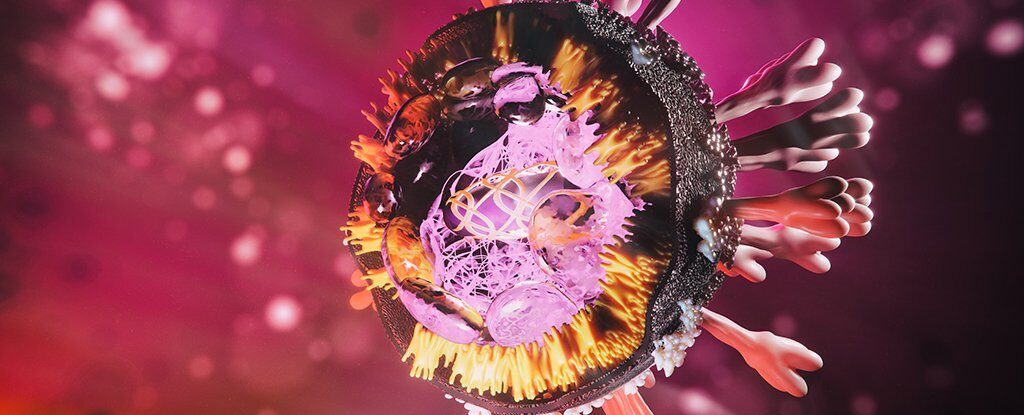Having a few chunks of virus code scattered among our genes doesn't necessarily mean the pandemic is here to stay. It could even go some way towards explaining why a handful of patients continue to test positive for COVID-19 long after recovery.
But SARS-CoV-2 simply isn't equipped with the tools to bury itself in our genetic library, meaning it would need a way to convince our own bodies to manage the job on its behalf.
"SARS-CoV-2 is not a retrovirus, which means it doesn't need reverse transcription for its replication," says biomedical researcher Liguo Zhang from MIT's Whitehead Institute.
"However, non-retroviral RNA virus sequences have been detected in the genomes of many vertebrate species, including humans."
Last year, Zhang and his team shared the initial results of an investigation suggesting SARS-CoV-2 might have a means of accomplishing such a task after all.
Using published data sets of infected cell cultures and patient samples, the team identified part-human, part-virus transcripts among sequences produced by the cells.
This was followed by experiments that assessed whether the presence of SARS-CoV-2 particles was enough to stimulate cells into producing certain enzymes that specialize in reverse transcribing RNA into DNA.
Their findings supported the rather concerning possibility that sequences of the coronavirus could be copied and pasted into our genome; importantly, not everybody in the scientific community was convinced by the evidence.
Partially due to the fact this research was made publicly available as a preprint before entering the peer-review process, it was met with significant skepticism by other researchers, who also noted the virus-human sequences could simply be artifacts of the very method used to find them.
Some expressed concerns it could make it harder to ease fears that vaccines based on the virus's code alter our DNA, an argument that might not disprove the results, but does emphasize the value in being certain of your findings before going public.
Comment: That's not science, that's politics, and it's rather insidious.
The criticisms were fair, as the researchers themselves conceded. So, the team went in search of more robust data to build their case.
Their work has now gone through peer review and is published in PNAS. In the updated study, the researchers have provided new reasons to think the coronavirus wreaking havoc on our global community might haunt our cells long after the infection is gone.
Comment: Coronavirus isn't wreaking havoc, lockdowns are; numerous countries that didn't lockdown, or did so with voluntary measures or only briefly, are proof of that: Reuters: Sweden had 10% lower 2020 death spike than much of Europe
In addition to looking for chimeras of coronavirus-human genetic fragments and watching for signs of the virus commandeering transcription tools, the team directly searched for evidence of viral sequences actually inside the human genome.
They even used three different DNA sequencing techniques to ensure their results weren't an artifact of any one technology.
In each case, they found fragments of SARS-CoV-2 genetic material slipped into the genetic library of deliberately infected cells, like pages torn from a contraband book.
The fact that half of the 'pages' were randomly inserted upside down adds weight to the argument that they weren't being inserted deliberately by living viruses.
On further inspection, the sequences to either side of these rogue elements weren't random pieces of text, either. The coding carried signatures of something called a transposon - a so-called jumping gene that evolved a means for falling out of place and inserting itself back into the genome elsewhere.
Some transposons manage this through the use of enzymes stolen from past viral infections; hijacked hardware that once used by viruses to edit themselves into a host, but now serve no master but the transposable sequence itself.
One such class of sequence, called LINE1 retrotransposons, make up a mind-blowing 17 percent of our entire genome. Though most have lost their talent for packing up and moving, some are active enough to still cause the occasional bit of mischief.
And it could be giving SARS-CoV-2 open access to our DNA.
"There's a very clear footprint for LINE1 integration," says one of the team, Whitehead Institute biologist Rudolf Jaenisch.
"At the junction of the viral sequence to the cellular DNA, it makes a 20 base pair duplication."
However, the fact this work was done in laboratory-infected cell cultures and not actual human hosts still leaves room for doubt. There's also the question of what it means - while the fragments aren't capable of building new infectious particles, it's far from clear whether they might be biologically active in other ways, for good or bad.
"At this point, we can only speculate," says Jaenisch.
With so much attention being given to this devastating pandemic, we can be confident that it won't be long before speculations will become solutions that ensure this coronavirus becomes just one more ghost in our bodies' graveyard of plagues.
This research was published in PNAS.




Comment: For insight into the likely origins of the coronavirus and its workings, check out SOTT's Compelling Evidence That SARS-CoV-2 Was Man-Made
See also: The Inanity of RNA Vaccines For COVID-19